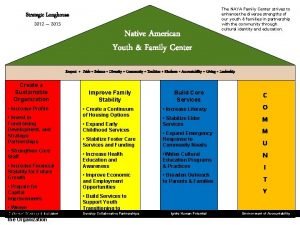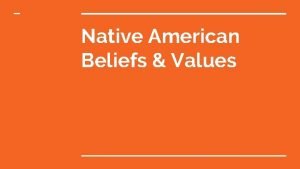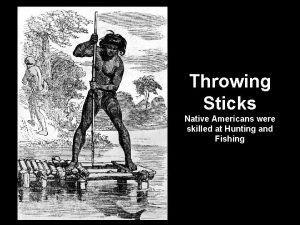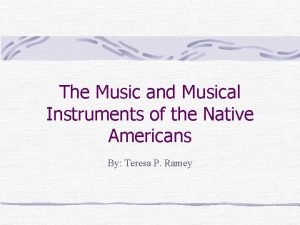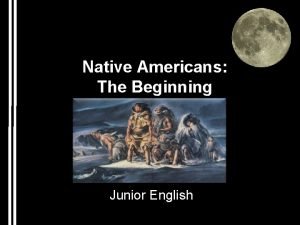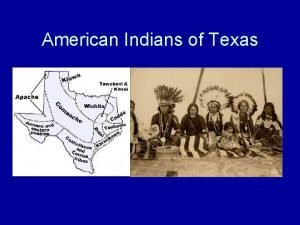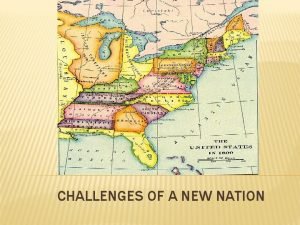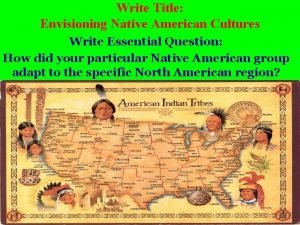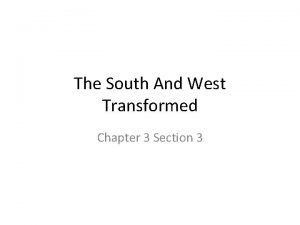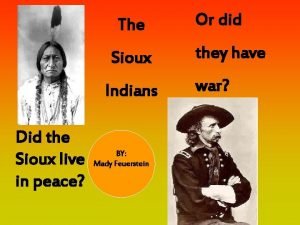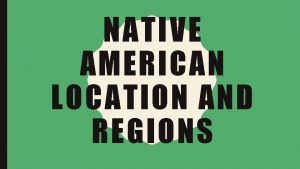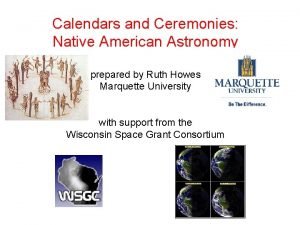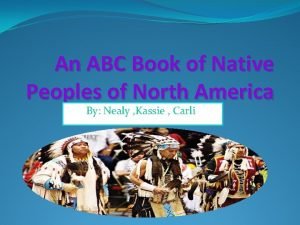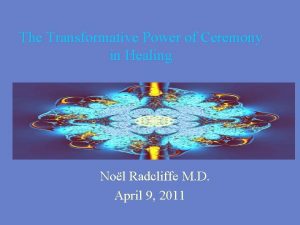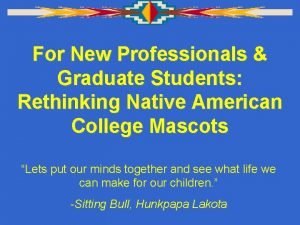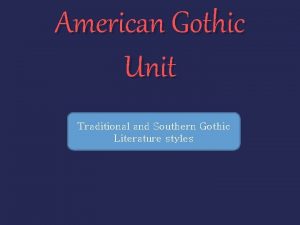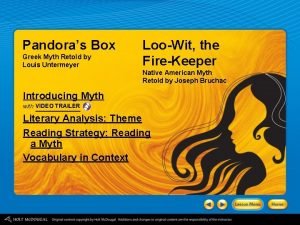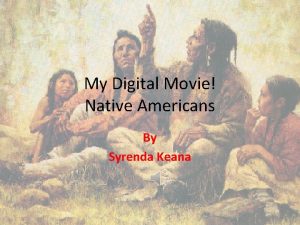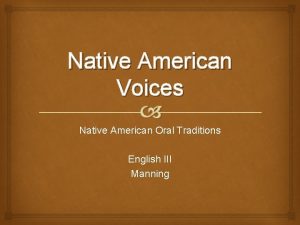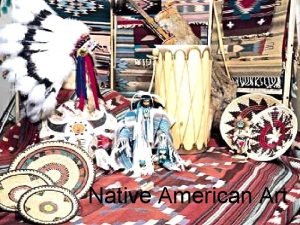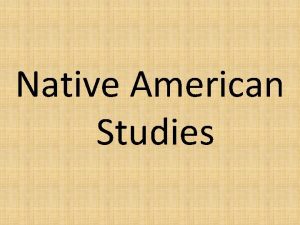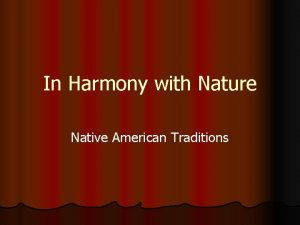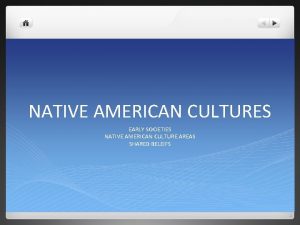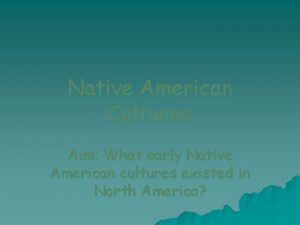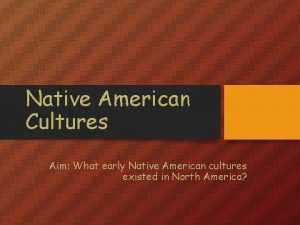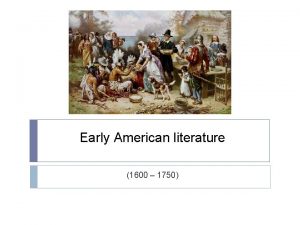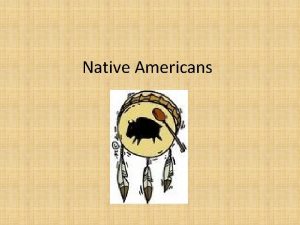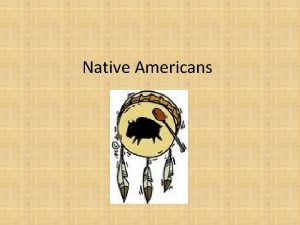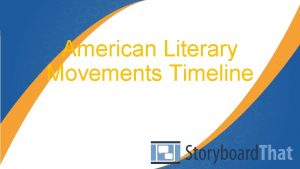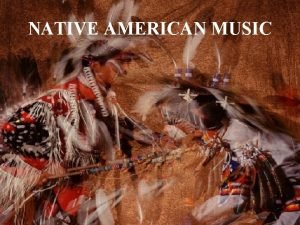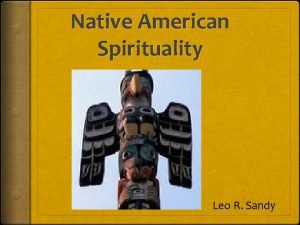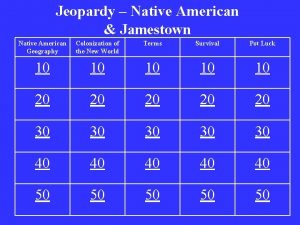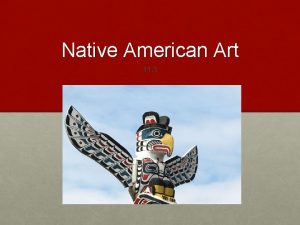Native American Traditions and Regions Early 1600 s





























- Slides: 29

Native American Traditions and Regions Early 1600 s Copyright © 2012 Jennifer Jackson All rights reserved by author. Permission to copy for single classroom use only. Electronic distribution limited to single classroom use only. Not for public display.

Traditions • Native American tribes were established in North America hundreds of years before the Europeans arrived. • Oral tradition – important role in each tribe; stories were passed down from generation to generation by word of mouth. Sequoyah, famous Cherokee Indian, with the alphabet he created. Source: http: //ushistoryimages. com/cherokee-indians. shtm

Myth • Myth – Native Americans used myths to explain human behavior and the universe. • Anonymous • Relied on supernatural to explain: • Natural phenomenon • Human behavior • Mystery of the universe • Myths helped people understand their world • Sometimes instruments (drums) were used for remembering long stories.

Creation Myth • Creation Myths tell how the world and human life came to exist • Emphasize bond between the Creator and the natural world • Many families believed they descended from animals or natural objects • Origin Myths • Explain how stars, moon came to exist • Explain why a society has specific beliefs • Tricksters • Animal characters who have two sides • One defies authority, creates mischief • Also curious and creative and reveal wisdom • Example: raven, coyote

View of nature • Appreciation and respect of nature was very important. • Native American spiritual stories were filled with symbols of weather, water, fire, air, etc. • Natural world was full of spirits. Navajo fire dance. Source: http: //ushistoryimages. com/navajo. shtm

Iroquois thanksgiving prayer • Thanksgiving We return thanks to our mother, the earth, which sustains us. We return thanks to the rivers and streams, which supply us with water. We return thanks to all herbs, which furnish medicines for the cure of our diseases. We return thanks to the moon and stars, which have given to us their light when the sun was gone. We return thanks to the sun, that has looked upon the earth with a beneficent eye. Lastly, we return thanks to the Great Spirit, in Whom is embodied all goodness, and Who directs all things for the good of Her children. ~ Iroquois ~ Source: http: //www. celebrating-thanksgiving. com/prayers/iroquois-prayer. shtml

Native American Regions

Eastern Woodlands • Extended from the Atlantic Ocean to the Plains and from the Great Lakes area to the Gulf of Mexico • Iroquois, Algonquin, Chippewa, Shawnee • Southeastern tribes: Cherokee, Choctaw, Chickasaw, Seminole • Moderate climate, plenty of rainfall, cold winters, long summers • Many lakes, rivers and hardwood forests • Tribes blended agriculture with hunting and gathering. • Used forest for food, shelter, tools, clothing, weapons • Northeast – used animals for food and clothing • Southeast – grew corn, squash, beans

Iroquois hunting camp wigwam • Source: http: //www. livinghistoryed. org/

Iroquois Chief • Source: http: //ushistoryimages. com/iroquois-indians. shtm

Eastern Woodlands • Wildlife – four seasons, moderate climate • • • White-tailed deer Raccoon Black bear Red-tailed hawk River otter • Vegetation – • Eastern Woodlands is known for a colorful display of vegetation in the fall • Oak, maple, beech, birch, hickory

Cherokee Nation • • Largest of the five civilized southeastern tribes Of Iroquois lineage (migrated) Agrarian people Lived in log homes – not teepees or wigwams Supported the British during the American Revolution Forced out of Georgia in the 1830 s Now the second largest tribe in the U. S.

Cherokee Indian council House • Source: http: //georgiainfo. galileo. usg. edu

Cherokee Women making pottery Source: http: //ushistoryima ges. com/cherokee. shtm

The Great Plains • Lived on the plains and rolling hills of the Great Plains of North America. • Two broad classification of tribes • Nomadic – Blackfoot, Cheyenne, Comanche, Kiowa • Survived on hunting • Bison – main source of food • Also used for weapons, utensils, clothing and décor • Tribes followed the grazing of the Bison • Used Spanish horses for transportation – faster travel • Semi-Sedentary – Iowa, Pawnee, Wichita • Hunted buffalo, lived in villages, planted crops, traded with other tribes.

The Great Plains • The United States government attempted to drive the Plains Indians away by killing off bison, their main source of food. • Bison posed a danger for locomotives because it was hard for the trains to stop in time when herds of bison were on the track. • By 1884, the bison was close to extinction. Source: http: //commons. wikimedia. org/wiki/File: Bison_bison_d. jpg

The Great Plains • Tribes wore bison skins in the winter • Believed all animals had spirits • Worshipped the Great Spirit – believed the spirit would help them become stronger • Earth was also important as the “mother of all spirits. ” • Sun Dance • Most important group ceremony • Tribes danced around a sacred object • Some people would harm themselves with the belief that they could encourage the spirits to support them. • Medicine Men (Shamans) healed people

Great Plains • Land – plains and rolling hills, prairies and grassland • West of the Mississippi River and east of the Rocky Mountains. • Dwelling – teepees were easily taken down when they needed to move • Wildlife – elk, bison, antelope • Vegetation – berries, wild greens, wild prairie turnip • Rainfall – only about a foot a year • Climate – cold, harsh winters; hot, humid summers; dust storms and high winds

Great Plains Teepees • Source: http: //people. ucls. uchicago. edu

Little Raven – Chief of the Arapaho Source: http: //ushistoryimages. co m/plains-indians. shtm

Southwest Desert Pima, Pueblo, Hopi, Acoma, Navajo tribes Area: Arizona, New Mexico and Colorado Dry, harsh climate People lived in multi-story houses made of adobe or stone Babies spent first year of life strapped to mother’s back in a papoose. • People grew corn, beans, melons, squash – animals were scarce in the desert. • Pottery and baskets are still popular today. • Turquois was used for jewelry-making • • • Promotes health and happiness

Southwest Desert • Climate – in the summers, temps can top 100 degrees • Monsoon season – late June to September • Dry season in spring – perfect for fires • • • River Systems – Colorado and Rio Grande Land – deep canyons, deserts River Valleys support willows, sycamore, fish Areas away from river support yucca, cactus, reptiles Wildlife – rattlesnakes, rabbits, coyotes, bobcats

Southwest – Kachina dolls • The Zuni and Hopi Southwest Indians carved dolls, called Kachina dolls, out of wood. • Dolls were decorated to depict Kachina spirits • Dolls helped children of the tribe learn tribal ceremonies. Source: http: //upload. wikimedia. org/wikipedia/commons/8/81/Kac hina_dolls. jpg

Pueblo Houses • Source: http: //ushistoryimages. com/pueblo-indian-dwellings. shtm

Navajo Indian • Source: http: //ushistoryimages. com/navajo. shtm

Pacific Northern Coast 200 -mile coast running from Northern California to Alaska Kwakiutl, Nookta, Haida, Chinook Waterways and forests, sea was very important People collected shellfish and hunted the ocean for whales, sea otters and seals • Extensive trade system that incorporated the Chinook Jargon language just for trade. • Prior to civilization, many of the tribes battles against each other and held captives as slaves. • •

Pacific Northern Coast • Totems • Decorated masks and boats with totems which were symbols of spirits of their ancestors • Families set totem poles in front of their homes (cedar-plank houses) • The totem pole showed a family’s wealth and status Source: http: //content. lib. washington. edu

Pacific Northern Coast • Potlatches • Potlatch – to give away, to give • Ceremony where a family would give away a large amount of their possessions. • Family’s reputation depended on how much they gave away. • Many families planned for years the event. • Often included singing, dancing, costumes and masks.

Pacific Northern Coast • Mild climate and rich natural resources • Massive forests of western red cedar, Douglas fir, hemlock • Salmon, grizzly and black bears, bald eagle, wolf Source: http: //www. groundtruthtrekking. org
 Native american literature definition
Native american literature definition Native american youth and family center
Native american youth and family center Native american morals and values
Native american morals and values Native american stick toss game
Native american stick toss game Native american musical instruments
Native american musical instruments How long have native american been living in america
How long have native american been living in america Native american religious beliefs
Native american religious beliefs Native american writing
Native american writing Medicine wheel theory
Medicine wheel theory Native american dwellings
Native american dwellings Famous new york street candy
Famous new york street candy Native american connections housing
Native american connections housing Native american important facts
Native american important facts Native american tribes
Native american tribes What three circumstances hurt native americans
What three circumstances hurt native americans Sioux writing
Sioux writing Native american skyscraper workers
Native american skyscraper workers Native american tribes in the united states
Native american tribes in the united states Chapter 14 test form a pre columbian america answers
Chapter 14 test form a pre columbian america answers Native american calendars
Native american calendars Native american abc book
Native american abc book Native american letting go ceremony
Native american letting go ceremony Crayola crayons
Crayola crayons Candy bar game
Candy bar game Native american literature syllabus
Native american literature syllabus Modern american gothic
Modern american gothic Pandora's box and loo-wit the fire keeper
Pandora's box and loo-wit the fire keeper Native american writing
Native american writing Keana inu
Keana inu Native american healing prayers for the sick
Native american healing prayers for the sick

